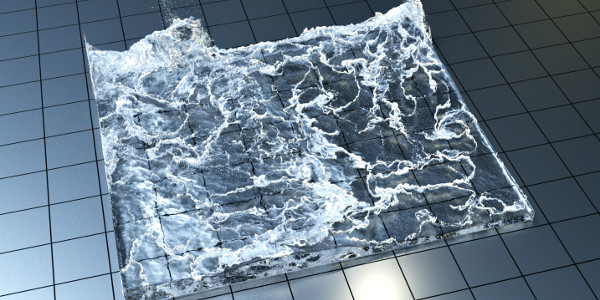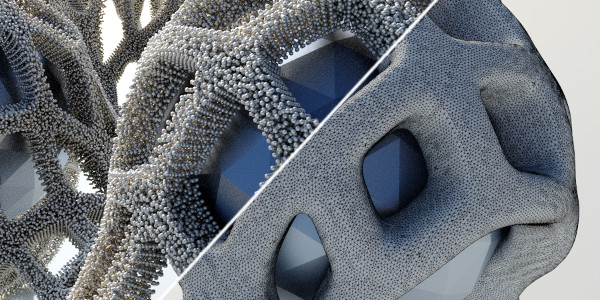FLIP Fluids is a powerful liquid simulation plugin that gives you the ability to create high quality fluid effects all within Blender, the free and open source 3D creation suite. Created by Ryan Guy and Dennis Fassbaender.
The core fluid engine, a modern FLIP-based fluid solver, has been under development for over four years with over two years of development focused on tightly integrating the simulator into Blender as an addon.
The FLIP Fluids simulator was created to improve on many aspects of Blender's internal Elbeem fluid simulation system such as speed, performance, accuracy, customizability, and user experience. We use a familiar and intuitive simulation workflow, so if you have experience with the internal fluid simulator or other fluid simulation software, you will be able to get yourself up and running with FLIP Fluids in no time!
You may purchase the FLIP Fluids addon on the Blender Market. Purchasing a license entitles you to to full FLIP Fluids feature set and content, tool support, and helps ensure the continued development of the addon. Thanks to the amazing support of the Blender community, we have been able to further develop the addon on a full-time basis for over a year!
You can get support for the FLIP Fluids addon by reading the documentation and wiki or through the Blender Market messaging system. Support is granted to all customers whom have purchased a license.
- Simulation
- Pause a simulation and resume baking at your convenience. Any simulation can be continued from the last baked frame even after a crash or computer shutdown.
- Set length of animation manually or automatically by framerate.
- Nearly all simulation settings can be keyframe animated.
- Hover over any setting to view a tooltip description. Detailed settings documentation and tips are also available on the Wiki.
- Want to keep the same level of simulation detail while resizing the domain? Lock the simulation voxel size and the addon will automatically adjust grid resolution as you resize the domain.
- Manage your scene cache directory. Operators will help you rename, move, copy, or delete your cache files.
- Advanced settings for power users who want to experiment with simulation accuracy and performance.
- Whitewater Simulation
- Control the amount of whitewater generated at wavecrests and in areas of high turbulence.
- Control how foam is carried along the fluid surface: In tight streaks, or diffuse and spread-out?
- Control how bubbles rise to the surface and how bubbles are advected with the fluid.
- Control amount of drag on spray particles as they fall to the fluid surface.
- Set percentages of foam/bubble/spray particles for display and rendering.
- Render whitewater particles with a simple icosphere or use your own custom object.
- Mesh Generator
- Adjust particle size for the particle-to-mesh surface generator.
- Create high detail meshes by increasing the subdivision level.
- Generate meshes that wrap smoothly around curved surfaces.
- Presets and Materials
- Save your own custom default domain settings.
- Create and manage domain presets.
- Organize presets into packages and add custom thumbnail images.
- Export and share preset packages.
- Apply multiple presets at once using the preset stack.
- Quickly apply materials from the fluid material library.
- Simulation Stats
- View simulation, timing, and mesh stats for the entire cache or an individual frame.
- Export stats to CSV format and create your own detailed graphs.
- Debugging Tools
- Visualize the simulation and meshing grid.
- Visualize fluid particles and velocities.
- Visualize how the simulator 'sees' your obstacle objects to diagnose issues with meshes.
- View detailed simulation progress in the Blender system console.
- Obstacle Objects
- Support for animated obstacle objects.
- Turn obstacle meshes 'inside-out' to contain fluid inside of the mesh.
- Accurate fluid-solid interaction against curved surfaces.
- Control amount of fluid friction against the obstacle surface.
- Fluid and Inflow Objects
- Support for animated inflow objects.
- Manually set inflow velocity, or set velocity towards a target object.
- Add inflow object velocity to the emitted fluid for realistic animated inflows.
- Outflow Objects
- Support for animated outflow objects.
- Control whether outflow objects remove fluid particles or whitewater particles.
- Control whether outflows will remove fluid entering the object or leaving the object.
- Windows, MacOS, or Linux operating system
- Blender 2.79 (64-bit) or *Blender 2.80 (64-bit)
- CPU 64-bit Intel® or AMD® multi-core processor
- 8 GB RAM minimum, 16 GB or more of RAM memory is highly recommended
At this moment, Blender 2.80 is is beta and our support for Blender 2.80 is experimental. Blender 2.80 is constantly changing and it is possible that a change in Blender 2.80 could break the addon in a daily build and we cannot guarantee that the addon will work in every daily build. A stable release of Blender 2.80 is planned for July 2019. See this document for known issues.
This program uses multiple licenses. See the files LICENSE_GPLv3.md, LICENSE_MIT.md, and LICENSE_Standard_Royalty_Free.md for license details. In General:
- The Blender addon code is licensed under the GPL.
- The fluid engine is licensed under the MIT license.
- Some addon content will be using a Standard Royalty Free license. This license may cover content such as media (images/textures/videos), Blend files, materials, presets. This content will only be included within the paid addon and will not be available on the GitHub project page.
Source code files will state their license at the top of the file. Assets will include a license file and information in their containing directory.
The FLIP Fluids addon is developed in our team's own private repository. Due to licensing restrictions, the project source contained in this public repository cannot contain the royalty-free content (See LICENSE_Standard_Royalty_Free.md) of the Blender Market product and cannot contain features that depend upon the royalty-free content. This public repository will often not be up-to-date with the private development repository. The full source code including all features and royalty-free content is distributed with the Blender Market product.
There are three dependencies to build this program:
- A compiler that supports C++11
- (optional) OpenCL headers (can be found at khronos.org)
- (optional) An OpenCL SDK specific to your GPU vender (AMD, NVIDIA, Intel, etc.)
WARNING: Compilation using MSVC (Microsoft Visual Studio Compiler) is experimental and not officially supported. Building with MSVC may result in errors and performance issues.
This program uses the CMake utility to generate the appropriate solution, project, or Makefiles for your system. The following commands can be executed in the root directory of the project to generate a build system for your machine:
mkdir build && cd build
cmake ..
The first line creates a new directory named build and changes the working directory to the newly created build directory. The second line runs the CMake utility and passes it the parent directory which contains the CMakeLists.txt file.
The type of build system generated by CMake can be specified with the -G [generator] parameter. For example:
cmake .. -G "MinGW Makefiles"
will generate Makefiles for the MinGW compiler which can then be built using the GNU Make utility with the command make. A list of CMake generators can be found here.
Once successfully built, the addon and python bindings will be located in the build/bl_flip_fluids/ directory.
See this documentation page for release notes: Release Notes






